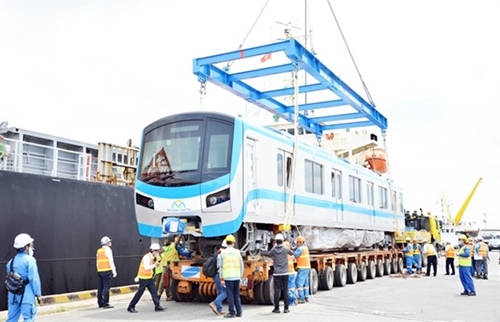The projects include the second phase of the Metro Line No.2, which connects Ben Thanh market with Thu Duc district’s Thu Thiem ward and Tham Luong to Tay Ninh bus station in Cu Chi district.
The second construction phase will be 9.1 kilometers in length and cost around USD 1.4 billion. It will help connect the city’s Northwestern regions to its center, as well as connect the Thu Thiem railway line to the future Long Thanh Airport in Dong Nai province.
    |
 |
|
A train for HCM City Metro Line No.1 is received in October last year. The city is planning to call for foreign investment for seven projects, including four metro lines. |
The second project, Metro Line No.3A (Ben Thanh – Tan Kien), is 19.5 kilometers long and costs USD 1.8 billion. It will connect to metro lines at the upcoming Ben Thanh Station in District 1 to transport travelers from the city center to Southwest provinces.
The third is Metro Line No.4 (Thanh Xuan – Hiep Phuoc Industrial Park), which is 36.2 kilometers long and costs over USD 4.5 billion. It will run across the city’s urban areas and Ben Thanh.
The last line is the first phase of Metro Line No.5 (Bay Hien intersection – Saigon Bridge), which is nearly 9 kilometers and will cost over USD 1.7 billion. This line was among the metro lines prioritized for investment in 2012 – 2015 and 2016 – 2020, but was unsuccessful in attracting investment.
For this metro line, the city wants to work with governmental organizations with official development assistance funds, large corporations, and traffic infrastructure investors that are financially and technologically capable.
Three other projects include Thu Thiem financial center, a center for conferences, exhibitions, hotel and commercial services, and a Rach Chiec Sport Complex, all of which are to be built in Thu Duc district.
The project proposal is part of a report on national projects to call for FDI, which the city People’s Committee has recently submitted to the Ministry of Planning and Investment.
The city has been facing challenges finding investment in such traffic projects because investors do not see the benefits of investing in the projects or are hesitant to invest because they are all done on a massive scale and require a vast amount of capital.
Regulations on private – public partnership investment in traffic and railway projects still contain some weaknesses, according to the city.
Source: VNA